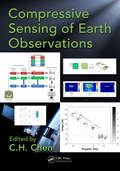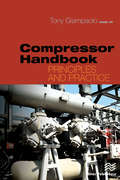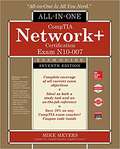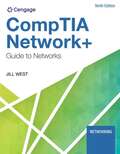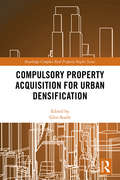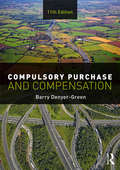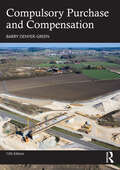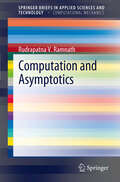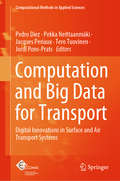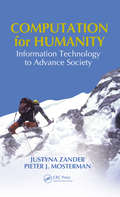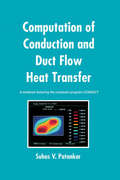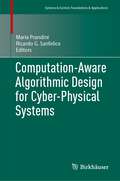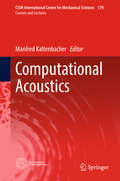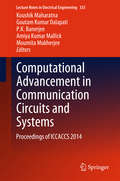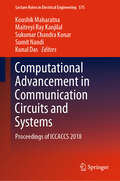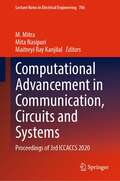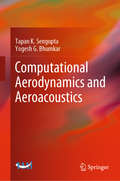- Table View
- List View
Compressive Sensing Based Algorithms for Electronic Defence (Signals and Communication Technology)
by Amit Kumar Mishra Ryno Strauss VersterThis book details some of the major developments in the implementation of compressive sensing in radio applications for electronic defense and warfare communication use. It provides a comprehensive background to the subject and at the same time describes some novel algorithms. It also investigates application value and performance-related parameters of compressive sensing in scenarios such as direction finding, spectrum monitoring, detection, and classification.
Compressive Sensing for Urban Radar
by Moeness AminWith the emergence of compressive sensing and sparse signal reconstruction, approaches to urban radar have shifted toward relaxed constraints on signal sampling schemes in time and space, and to effectively address logistic difficulties in data acquisition. Traditionally, these challenges have hindered high resolution imaging by restricting both bandwidth and aperture, and by imposing uniformity and bounds on sampling rates. Compressive Sensing for Urban Radar is the first book to focus on a hybrid of two key areas: compressive sensing and urban sensing. It explains how reliable imaging, tracking, and localization of indoor targets can be achieved using compressed observations that amount to a tiny percentage of the entire data volume. Capturing the latest and most important advances in the field, this state-of-the-art text: Covers both ground-based and airborne synthetic aperture radar (SAR) and uses different signal waveforms Demonstrates successful applications of compressive sensing for target detection and revealing building interiors Describes problems facing urban radar and highlights sparse reconstruction techniques applicable to urban environments Deals with both stationary and moving indoor targets in the presence of wall clutter and multipath exploitation Provides numerous supporting examples using real data and computational electromagnetic modeling Featuring 13 chapters written by leading researchers and experts, Compressive Sensing for Urban Radar is a useful and authoritative reference for radar engineers and defense contractors, as well as a seminal work for graduate students and academia.
Compressive Sensing for Wireless Communication: Challenges and Opportunities (River Publishers Series In Communications Ser.)
by Radha Sankararajan Hemalatha Rajendran Aasha Nandhini SukumaranCompressed Sensing (CS) is a promising method that recovers the sparse and compressible signals from severely under-sampled measurements. CS can be applied to wireless communication to enhance its capabilities. As this technology is proliferating, it is possible to explore its need and benefits for emerging applicationsCompressive Sensing for Wireless Communication provides:• A clear insight into the basics of compressed sensing• A thorough exploration of applying CS to audio, image and computer vision• Different dimensions of applying CS in Cognitive radio networks• CS in wireless sensor network for spatial compression and projection• Real world problems/projects that can be implemented and tested• Efficient methods to sample and reconstruct the images in resource constrained WMSN environmentThis book provides the details of CS and its associated applications in a thorough manner. It lays a direction for students and new engineers and prepares them for developing new tasks within the field of CS. It is an indispensable companion for practicing engineers who wish to learn about the emerging areas of interest.
Compressive Sensing for Wireless Networks
by Wotao Yin Zhu Han Husheng LiCompressive sensing is a new signal processing paradigm that aims to encode sparse signals by using far lower sampling rates than those in the traditional Nyquist approach. It helps acquire, store, fuse and process large data sets efficiently and accurately. This method, which links data acquisition, compression, dimensionality reduction and optimization, has attracted significant attention from researchers and engineers in various areas. This comprehensive reference develops a unified view on how to incorporate efficiently the idea of compressive sensing over assorted wireless network scenarios, interweaving concepts from signal processing, optimization, information theory, communications and networking to address the issues in question from an engineering perspective. It enables students, researchers and communications engineers to develop a working knowledge of compressive sensing, including background on the basics of compressive sensing theory, an understanding of its benefits and limitations, and the skills needed to take advantage of compressive sensing in wireless networks.
Compressive Sensing of Earth Observations (Signal and Image Processing of Earth Observations)
by C. H. ChenFuture remote sensing systems will make extensive use of Compressive Sensing (CS) as it becomes more integrated into the system design with increased high resolution sensor developments and the rising earth observation data generated each year. Written by leading experts in the field Compressive Sensing of Earth Observations provides a comprehensive and balanced coverage of the theory and applications of CS in all aspects of earth observations. This work covers a myriad of practical aspects such as the use of CS in detection of human vital signs in a cluttered environment and the corresponding modeling of rib-cage breathing. Readers are also presented with three different applications of CS to the ISAR imaging problem, which includes image reconstruction from compressed data, resolution enhancement, and image reconstruction from incomplete data.
Compressor Handbook: Principles and Practice
by Anthony GiampaoloThis book provides a practical introduction to dynamic and positive displacement compressors, including compressor performance, operation, and problem awareness. In reading this book readers will learn what is needed to select, operate, and troubleshoot compressors. Complete with real-life case histories, the book demonstrates investigative techniques for identifying and isolating various contributing causes, including design deficiencies, manufacturing defects, adverse environmental conditions, operating errors, and intentional or unintentional changes of the machinery process that usually precede failure.
Compressor Handbook: Principles and Practice
by Tony GiampaoloThis book examines the full spectrum of compressor types, how they operate, how to control them, and how operating conditions can significantly impact their performance. Discussed in detail are the influence of pressure, temperature, molecular weight, specific heat ratio, compression ratio, speed, vane position, and volume bottles. The various methods of throughput control are also addressed, including discharge throttling, suction throttling, guide pain positioning, volume, bottles, suction valve unloaders, speed control, as well as how each of these control methods affects compressor life. Compressor surge is defined and discussed in detail, along with the types of instrumentation (controllers, valves, pressure, and temperature transmitters) available, and which of those are most suitable for controlling search. Case studies have been included to illustrate the principles covered in the text. This edition also includes detailed information on compressor seals. Various types of seals providing the best results for different applications are discussed, thereby giving the reader a basic understanding of seals serotypes and applications.
Comptia Network+ Certification All-in-One Exam Guide, Seventh Edition (Exam N10-007)
by Mike MeyersThoroughly revised for the new CompTIA Network+ exam, the Seventh Edition of this bestselling All-in-One Exam Guide delivers 100% coverage of the exam objectives and serves as a valuable on-the-job reference <P><P>Take the latest version of the CompTIA Network+ exam with complete confidence using the fully updated information contained in this comprehensive self-study system. The book offers clear instruction and real-world examples from training expert and bestselling author Mike Meyers along with hundreds of accurate practice questions. <P><P>Fulfilling the promise of the All-in-One series, this complete reference serves both as a study tool and a valuable on-the-job reference that will serve readers beyond the exam. CompTIA Network+ Certification All-in-One Exam Guide, Seventh Edition (Exam N10-007) also includes access to free video training and interactive hands-on labs and simulations that prepare you for difficult performance-based questions. A valuable pre-assessment test enables readers to gauge their familiarity with the test’s objectives and tailor an effective course for study. <P><P>Contains complete coverage of every objective for the CompTIA Network+ Certification exam <P><P>Written by CompTIA training and certification guru Mike Meyers <P><P>Electronic content includes the Total Tester exam simulator with over 100 practice questions, over an hour of training videos, and a collection of Mike Meyers’ favorite shareware and freeware networking utilities
Comptia Network+ Guide To Networks (Mindtap Course List Ser.)
by Jill WestMaster the technical skills and industry knowledge you need to begin an exciting career installing, configuring and troubleshooting computer networks with West's completely updated NETWORK+ GUIDE TO NETWORKS, 9E. This resource thoroughly prepares you for success on the latest CompTIA's Network+ N10-008 certification exam as content corresponds to all exam objectives, including protocols, topologies, hardware, network design, security and troubleshooting. Detailed, step-by-step instructions as well as cloud, virtualization and simulation projects give you experience working with a variety of hardware, software and operating systems as well as device interactions. Stories from professionals on the job, insightful discussion prompts, hands-on activities, applications and projects all guide you in exploring key concepts in-depth. You gain the problem-solving tools for any computing environment. MindTap digital resources are also available for additional practice and certification prep.
Compulsory Property Acquisition for Urban Densification (Routledge Complex Real Property Rights Series)
by Glen SearleDensification has been a central method of achieving smart, sustainable cities across the world. This book explores international examples of the property rights tensions involved in attempting to develop denser, more sustainable cities through compulsory acquisition of property. The case studies from Europe, North America, eastern Asia and Australia show how well, or not, property rights have been recognised in each country. Chapters explore the significance of local legal frameworks and institutions in accommodating property rights in the densification process. In particular, the case studies address the following issues and more: Whether compulsory acquisition to increase densification is justified in practice and in theory The specific public benefits given for compulsory acquisition The role the development industry plays in facilitating, encouraging or promoting compulsory acquisition What compensation or offsets are offered for acquisition, and how are they funded? Is there a local or national history of compulsory property acquisition by government for a range of purposes? Is compulsory acquisition restricted to certain types or locations of densification? Where existing housing is acquired, are there obligations to provide alternative housing arrangements? The central aim of the book is to summarize international experiences of the extent to which property rights have or have not been protected in the use of compulsory property acquisition to achieve sustainable cities via urban densification. It is essential reading for all those interested in planning law, property rights, environmental law, urban studies, sustainable urban development and land use policy.
Compulsory Purchase and Compensation
by Barry Denyer-GreenCompulsory Purchase and Compensation is the essential guide to this complex and increasingly relevant area of the law. Now in its eleventh edition, no other book presents the same level of information on the law relating to compulsory purchase and compensation in England and Wales in such an accessible way. The best-selling book on the subject, previous editions have been used by professionals and students alike in order to gain a full understanding of a key subject for any surveyor or lawyer. The book is also especially suited to those coming to this complex subject without a specific background in the law and ideal reading for those students taking planning and built environment law modules. Surveyors in particular will find this book invaluable. This new edition has been extensively revised and reflects the changes to the law in the Housing and Planning Act 2016 and the Neighbourhood Planning Act 2017, and also recent decisions of the courts and the Upper Tribunal, all of which will be of particular interest to those working on cases related to HS2, the proposed high-speed railway line from London to Birmingham, Leeds and Manchester.
Compulsory Purchase and Compensation
by Barry Denyer-GreenCompulsory Purchase and Compensation remains the essential guide to this complex and increasingly relevant area of the law. Now in its 12th edition, no other book presents the same level of information on the law relating to compulsory purchase and compensation in England and Wales in such an accessible way.The book is also especially suited to those coming to this complex subject without a specific background in the law and is ideal reading for those students taking planning and built environment modules. Surveyors in particular will find this book invaluable.Whilst this new edition picks up the very many decisions of the Upper Tribunal and the higher courts since the 11th edition, the principal piece of new legislation is the Levelling-up and Regeneration Act 2023. One of the controversial provisions in the 2023 Act is the power to include in a compulsory purchase order a direction, the effect of which is that in relation to certain limited purposes, compensation shall be assessed on the basis that no planning permission would be granted for development on the relevant land; in effect, no hope value and only existing use values would be paid.
Computation and Asymptotics (SpringerBriefs in Applied Sciences and Technology)
by Rudrapatna V. RamnathThis book addresses the task of computation from the standpoint of asymptotic analysis and multiple scales that may be inherent in the system dynamics being studied. This is in contrast to the usual methods of numerical analysis and computation. The technical literature is replete with numerical methods such as Runge-Kutta approach and its variations, finite element methods, and so on. However, not much attention has been given to asymptotic methods for computation, although such approaches have been widely applied with great success in the analysis of dynamic systems. The presence of different scales in a dynamic phenomenon enable us to make judicious use of them in developing computational approaches which are highly efficient. Many such applications have been developed in such areas as astrodynamics, fluid mechanics and so on. This book presents a novel approach to make use of the different time constants inherent in the system to develop rapid computational methods. First, the fundamental notions of asymptotic analysis are presented with classical examples. Next, the novel systematic and rigorous approaches of system decomposition and reduced order models are presented. Next, the technique of multiple scales is discussed. Finally application to rapid computation of several aerospace systems is discussed, demonstrating the high efficiency of such methods.
Computation and Big Data for Transport: Digital Innovations in Surface and Air Transport Systems (Computational Methods in Applied Sciences #54)
by Pekka Neittaanmäki Tero Tuovinen Jacques Periaux Pedro Diez Jordi Pons-PratsThis book gathers the outcomes of the second ECCOMAS CM3 Conference series on transport, which addressed the main challenges and opportunities that computation and big data represent for transport and mobility in the automotive, logistics, aeronautics and marine-maritime fields. Through a series of plenary lectures and mini-forums with lectures followed by question-and-answer sessions, the conference explored potential solutions and innovations to improve transport and mobility in surface and air applications. The book seeks to answer the question of how computational research in transport can provide innovative solutions to Green Transportation challenges identified in the ambitious Horizon 2020 program. In particular, the respective papers present the state of the art in transport modeling, simulation and optimization in the fields of maritime, aeronautics, automotive and logistics research. In addition, the content includes two white papers on transport challenges and prospects. Given its scope, the book will be of interest to students, researchers, engineers and practitioners whose work involves the implementation of Intelligent Transport Systems (ITS) software for the optimal use of roads, including safety and security, traffic and travel data, surface and air traffic management, and freight logistics.
Computation and Visualization for Understanding Dynamics in Geographic Domains: A Research Agenda
by May Yuan Kathleen S. HornsbyThe world is ever changing, and a comprehensive understanding of the world will not be achieved without theoretical and methodological advances to decode complex dynamics in human and environmental systems. Computation and Visualization for the Understanding of Dynamics in Geographic Domains: A Research Agenda synthesizes key ideas and issu
Computation for Humanity: Information Technology to Advance Society (Computational Analysis, Synthesis, and Design of Dynamic Systems)
by Pieter J. Mosterman Justyna ZanderThe exponential progress and accessibility of computing has vastly increased data flows and revolutionized the practice of science, engineering, and communication. Computing plays a critical role in advancing research across almost every scientific discipline. Computation for Humanity: Information Technology to Advance Society is a guide for the creation of services, products, and tools that facilitate, support, and enhance progress of humanity toward more sustainable life. This book: Provides a deep understanding of the practical applications of computation to solve human-machine problems Delivers insight into theoretical approaches in an accessible manner Provides a comprehensive overview of computational science and engineering applications in selected disciplines Crosses the boundaries between different domains and shows how they interrelate and complement one another Focuses on grand challenges and issues that matter for the future of humanity Shows different perspectives of computational thinking, understanding, and reasoning Provides a basis for scientific discoveries and enables adopting scientific theories and engineering practices from other disciplines Takes a step back to provide a human-related abstraction level that is not ultimately seen in pure technological elaborations/collections The editors provide a collection of numerous computation-related projects that form a foundation from which to cross-pollinate between different disciplines and further extensive collaboration. They present a clear and profound understanding of computing in today's world, and provide fundamental solutions to some of the most pertinent humanity-related problems.
Computation of Conduction and Duct Flow Heat Transfer
by Suhas V. PatankarThis book describes the computer program CONDUCT in terms of its physical, mathematical, and computational details and its application to heat conduction and duct flow problems. It aims to develop students' problem-solving skills as well as enhance their understanding of these physical processes.
Computation of Nonlinear Structures
by Debabrata RayComprehensively introduces linear and nonlinear structural analysis through mesh generation, solid mechanics and a new numerical methodology called c-type finite element method Takes a self-contained approach of including all the essential background materials such as differential geometry, mesh generation, tensor analysis with particular elaboration on rotation tensor, finite element methodology and numerical analysis for a thorough understanding of the topics Presents for the first time in closed form the geometric stiffness, the mass, the gyroscopic damping and the centrifugal stiffness matrices for beams, plates and shells Includes numerous examples and exercises Presents solutions for locking problems
Computation of Viscous Incompressible Flows (Scientific Computation)
by Cetin C. Kiris Dochan KwakThis monograph is intended as a concise and self-contained guide to practitioners and graduate students for applying approaches in computational fluid dynamics (CFD) to real-world problems that require a quantification of viscous incompressible flows. In various projects related to NASA missions, the authors have gained CFD expertise over many years by developing and utilizing tools especially related to viscous incompressible flows. They are looking at CFD from an engineering perspective, which is especially useful when working on real-world applications. From that point of view, CFD requires two major elements, namely methods/algorithm and engineering/physical modeling. As for the methods, CFD research has been performed with great successes. In terms of modeling/simulation, mission applications require a deeper understanding of CFD and flow physics, which has only been debated in technical conferences and to a limited scope. This monograph fills the gap by offering in-depth examples for students and engineers to get useful information on CFD for their activities. The procedural details are given with respect to particular tasks from the authors' field of research, for example simulations of liquid propellant rocket engine subsystems, turbo-pumps and the blood circulations in the human brain as well as the design of artificial heart devices. However, those examples serve as illustrations of computational and physical challenges relevant to many other fields. Unlike other books on incompressible flow simulations, no abstract mathematics are used in this book. Assuming some basic CFD knowledge, readers can easily transfer the insights gained from specific CFD applications in engineering to their area of interest.
Computation-Aware Algorithmic Design for Cyber-Physical Systems (Systems & Control: Foundations & Applications)
by Ricardo G. Sanfelice Maria PrandiniThis contributed volume aims to build the foundation of a framework for computationally aware algorithmic design for cyber-physical systems (CPSs), focusing on approaches that take computation into account at the design stage to address their impact on performance and safety. It demonstrates how novel techniques may emerge from the combination of formal methods, model predictive control, distributed optimization, data-driven methods, reconfigurable/adaptive methods, and information-theoretic techniques.Chapters are written by both researchers and practitioners and cover such topics as analysis and design of uncertain CPSs, cooperative and non-cooperative paradigms for handling complexity in large scale CPSs,task-relevant environment abstractions for autonomous systems based on information theory,information flow in event-based stabilization of CPSs,set-valued model predictive control, andautomated synthesis of certifiable controllers for CPSs.State-of-the-art applications and case studies are provided throughout with a special focus on intelligent transportation systems and autonomous vehicles.Graduate students and researchers with an interest in CPS verification and control will find this volume to be a valuable resource in their work. It will also appeal to researchers from disciplines other than control, such as computer science, operations research, applied mathematics, and robotics.
Computational Acoustics (CISM International Centre for Mechanical Sciences #579)
by Manfred KaltenbacherThe book presents a state-of-art overview of numerical schemes efficiently solving the acoustic conservation equations (unknowns are acoustic pressure and particle velocity) and the acoustic wave equation (pressure of acoustic potential formulation). Thereby, the different equations model both vibrational- and flow-induced sound generation and its propagation. Latest numerical schemes as higher order finite elements, non-conforming grid techniques, discontinuous Galerkin approaches and boundary element methods are discussed. Main applications will be towards aerospace, rail and automotive industry as well as medical engineering. The team of authors are able to address these topics from the engineering as well as numerical points of view.
Computational Advancement in Communication Circuits and Systems: Proceedings of ICCACCS 2014 (Lecture Notes in Electrical Engineering #335)
by Koushik Maharatna Goutam Kumar Dalapati P. K. Banerjee Amiya Kumar Mallick Moumita MukherjeeThis book comprises the proceedings of 1st International Conference on Computational Advancement in Communication Circuits and Systems (ICCACCS 2014) organized by Narula Institute of Technology under the patronage of JIS group, affiliated to West Bengal University of Technology. The conference was supported by Technical Education Quality Improvement Program (TEQIP), New Delhi, India and had technical collaboration with IEEE Kolkata Section, along with publication partner by Springer. The book contains 62 refereed papers that aim to highlight new theoretical and experimental findings in the field of Electronics and communication engineering including interdisciplinary fields like Advanced Computing, Pattern Recognition and Analysis, Signal and Image Processing. The proceedings cover the principles, techniques and applications in microwave & devices, communication & networking, signal & image processing, and computations & mathematics & control. The proceedings reflect the conference's emphasis on strong methodological approaches and focus on applications within the domain of Computational Advancement in Communication Circuits and Systems. The content also emphasizes the emerging technologies in the Electronics and Communication field together in close examinations of practices, problems and trends.
Computational Advancement in Communication Circuits and Systems: Proceedings of ICCACCS 2018 (Lecture Notes in Electrical Engineering #575)
by Koushik Maharatna Kunal Das Maitreyi Ray Kanjilal Sukumar Chandra Konar Sumit NandiThis book gathers the proceedings of the International Conference on Computational Advancement in Communication Circuits and Systems (ICCACCS 2018), which was organized by Narula Institute of Technology under the patronage of the JIS group, affiliated with West Bengal University of Technology. The book presents peer-reviewed papers that highlight new theoretical and experimental findings in the fields of electronics and communication engineering, including interdisciplinary areas like Advanced Computing, Pattern Recognition and Analysis, and Signal and Image Processing. The respective papers cover a broad range of principles, techniques and applications in microwave devices, communication and networking, signal and image processing, computations and mathematics, and control. The proceedings reflect the conference’s strong emphasis on methodological approaches, and focus on applications within the domain of Computational Advancement in Communication Circuits and Systems. They also address emerging technologies in electronics and communication, together with the latest practices, issues and trends.
Computational Advancement in Communication, Circuits and Systems: Proceedings of 3rd ICCACCS 2020 (Lecture Notes in Electrical Engineering #786)
by Maitreyi Ray Kanjilal M. Mitra Mita NasipuriThis book gathers the proceedings of the Third International Conference on Computational Advancement in Communication Circuits and Systems (ICCACCS 2020), organized virtually by Narula Institute of Technology, Kolkata, India. The book presents peer-reviewed papers that highlight new theoretical and experimental findings in the fields of electronics and communication engineering, including interdisciplinary areas like advanced computing, pattern recognition and analysis, and signal and image processing. The respective papers cover a broad range of principles, techniques, and applications in microwave devices, communication and networking, signal and image processing, computations and mathematics, and control.
Computational Aerodynamics and Aeroacoustics
by Tapan K. Sengupta Yogesh G. BhumkarRecent advances in scientific computing have caused the field of aerodynamics to change at a rapid pace, simplifying the design cycle of aerospace vehicles enormously – this book takes the readers from core concepts of aerodynamics to recent research, using studies and real-life scenarios to explain problems and their solutions. This book presents in detail the important concepts in computational aerodynamics and aeroacoustics taking readers from the fundamentals of fluid flow and aerodynamics to a more in-depth analysis of acoustic waves, aeroacoustics, computational modelling and processing. This book will be of use to students in multiple branches of engineering, physics and applied mathematics. Additionally, the book can also be used as a text in professional development courses for industry engineers and as a self-help reference for active researchers in both academia and the industry.




